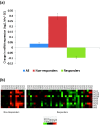Understanding the mechanisms of aromatase inhibitor resistance
- PMID: 22277572
- PMCID: PMC3496110
- DOI: 10.1186/bcr2931
Understanding the mechanisms of aromatase inhibitor resistance
Abstract
Aromatase inhibitors (AIs) have a central role in the treatment of breast cancer; however, resistance is a major obstacle to optimal management. Evidence from endocrine, molecular and pathological measurements in clinical material taken before and after therapy with AIs and data from clinical trials in which AIs have been given as treatment either alone or in combination with other targeted agents suggest diverse causes for resistance. These include inherent tumour insensitivity to oestrogen, ineffective inhibition of aromatase, sources of oestrogenic hormones independent of aromatase, activation of signalling by non-endocrine pathways, enhanced cell survival and selection of hormone-insensitive cellular clones during treatment.
Figures



Similar articles
-
Aromatase inhibitors and breast cancer.Minerva Endocrinol. 2006 Mar;31(1):27-46. Minerva Endocrinol. 2006. PMID: 16498362 Review.
-
Mechanisms of resistance to aromatase inhibitors.J Steroid Biochem Mol Biol. 2005 May;95(1-5):167-72. doi: 10.1016/j.jsbmb.2005.04.022. J Steroid Biochem Mol Biol. 2005. PMID: 15982868 Review.
-
Endocrinology and hormone therapy in breast cancer: aromatase inhibitors versus antioestrogens.Breast Cancer Res. 2004;6(6):269-74. doi: 10.1186/bcr945. Epub 2004 Oct 6. Breast Cancer Res. 2004. PMID: 15535858 Free PMC article. Review.
-
Anti-tumor efficacy of new 7α-substituted androstanes as aromatase inhibitors in hormone-sensitive and resistant breast cancer cells.J Steroid Biochem Mol Biol. 2017 Jul;171:218-228. doi: 10.1016/j.jsbmb.2017.04.002. Epub 2017 Apr 7. J Steroid Biochem Mol Biol. 2017. PMID: 28396197
-
Biological rationale for endocrine therapy in breast cancer.Best Pract Res Clin Endocrinol Metab. 2004 Mar;18(1):1-32. doi: 10.1016/s1521-690x(03)00044-7. Best Pract Res Clin Endocrinol Metab. 2004. PMID: 14687595 Review.
Cited by
-
A Role for Histone H2B Variants in Endocrine-Resistant Breast Cancer.Horm Cancer. 2015 Dec;6(5-6):214-24. doi: 10.1007/s12672-015-0230-5. Epub 2015 Jun 26. Horm Cancer. 2015. PMID: 26113056 Free PMC article.
-
Synthesis and Biological Evaluation of 1-(Diarylmethyl)-1H-1,2,4-triazoles and 1-(Diarylmethyl)-1H-imidazoles as a Novel Class of Anti-Mitotic Agent for Activity in Breast Cancer.Pharmaceuticals (Basel). 2021 Feb 22;14(2):169. doi: 10.3390/ph14020169. Pharmaceuticals (Basel). 2021. PMID: 33671674 Free PMC article.
-
Breast cancer stem-like cells are sensitized to tamoxifen induction of self-renewal inhibition with enforced Let-7c dependent on Wnt blocking.Int J Mol Med. 2018 Apr;41(4):1967-1975. doi: 10.3892/ijmm.2018.3388. Epub 2018 Jan 15. Int J Mol Med. 2018. PMID: 29336465 Free PMC article.
-
A Digital RNA Signature of Circulating Tumor Cells Predicting Early Therapeutic Response in Localized and Metastatic Breast Cancer.Cancer Discov. 2018 Oct;8(10):1286-1299. doi: 10.1158/2159-8290.CD-18-0432. Epub 2018 Aug 13. Cancer Discov. 2018. PMID: 30104333 Free PMC article.
-
Quantitative Proteomic Profiling Identifies a Potential Novel Chaperone Marker in Resistant Breast Cancer.Front Oncol. 2021 Feb 25;11:540134. doi: 10.3389/fonc.2021.540134. eCollection 2021. Front Oncol. 2021. PMID: 33718123 Free PMC article.
References
-
- Winer EP, Hudis C, Burstein HJ, Wolff AC, Pritchard KI, Ingle JN, Chlebowski RT, Gelber R, Edge SB, Gralow J, Cobleigh MA, Mamounas EP, Goldstein LJ, Whelan TJ, Powles TJ, Bryant J, Perkins C, Perotti J, Braun S, Langer AS, Browman GP, Somerfield MR. American Society of Clinical Oncology technology assessment on the use of aromatase inhibitors as adjuvant therapy for postmenopausal women with hormone receptor-positive breast cancer: status report 2004. J Clin Oncol. 2005;23:619–629. - PubMed
-
- Miller WR. Aromatase inhibitors and breast cancer. Minerva Endocrinol. 2006;31:27–46. - PubMed
-
- Lonning PE. Pharmacology of new aromatase inhibitors. Breast. 1996;5:202–206. doi: 10.1016/S0960-9776(96)90094-6. - DOI
-
- Geisler J, Haynes B, Anker G, Dowsett M, Lønning PE. Influence of letrozole and anastrozole on total body aromatization and plasma estrogen levels in postmenopausal breast cancer patients evaluated in a randomized, cross-over study. J Clin Oncol. 2002;20:751–757. doi: 10.1200/JCO.20.3.751. - DOI - PubMed
-
- Dowsett M. Preoperative models to evaluate endocrine strategies for breast cancer. Clin Cancer Res. 2003;9:502S–510S. - PubMed
Publication types
MeSH terms
Substances
LinkOut - more resources
Full Text Sources
Other Literature Sources

